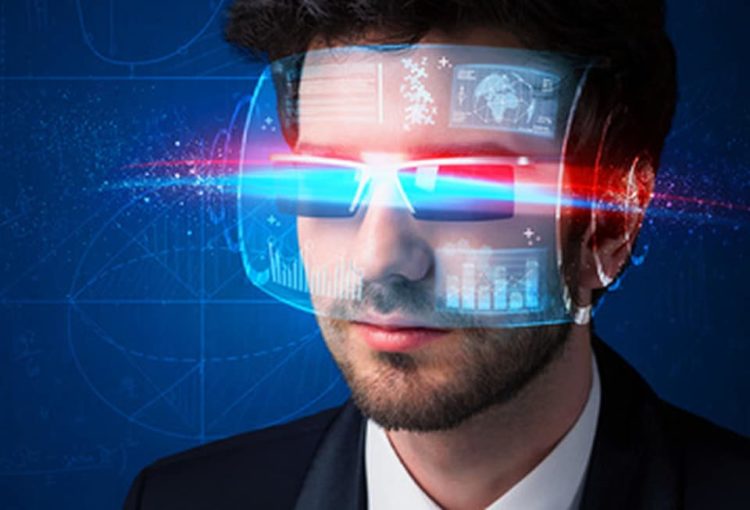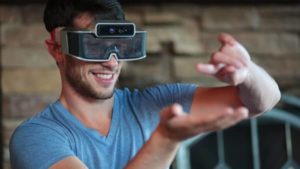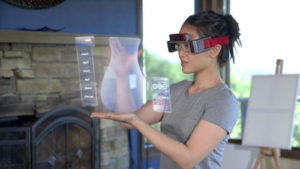Augmented Reality Glasses Coming into View : A Well Thought Out Scream by James Riordan

Augmented reality is becoming a reality. Defined as a direct or indirect view of the world whose elements are augmented (or supplemented) by computer-generated sensory input, Augmented Reality (AR) employs sound, video, graphics or GPS data to change the view through special glasses. It is related to a more general concept called “mediated” reality, in which a view of reality is modified (possibly even diminished rather than augmented) by computer. The technology works by enhancing one’s current perception of reality.
Virtual reality replaces the real world with a simulated one, but augmented reality occurs in real time and in semantic context with other environmental elements, such as sports scores on TV during a match. With the help of advanced AR technology (e.g. adding computer vision and object recognition) the information about the surrounding real world of the user becomes interactive and can be digitally influenced. Information about the environment and its objects is overlaid on the real world. This information can be virtual or real, e.g. seeing other real sensed or measured information such as electromagnetic radio waves overlaid in exact alignment with where they actually are in space. Augmented reality brings out the components of the digital world into a person’s perceived real world. One example is AR Glasses for construction workers that displays information about the construction sites.
This year saw an important milestone this year in when two technology titans announced their intentions to bring AR to the mass consumer market via mobile devices. Apple proclaimed the release of its new ARKit in June, soon followed by the debut of Google’s ARCore in August, with both companies developing new consumer-oriented AR games and apps.The hardware components for augmented reality devices include sensors, processors, display and input devices. Devices like smartphones and tablet computers often include a camera and MEMS sensors such as accelerometer, GPS, and solid state compass, making them suitable AR platforms. At this time it’s too early to know what the new ecosystem of software and hardware designed to provide AR experiences will evolve into in the future, but it’s safe to predict that AR headsets will be part of the picture.
So why is AR suddenly ready for mass consumption? And why aren’t we leaping (magically!) into AR glasses? The answers are simple enough: Technology takes time to develop, and users need time to adapt. With any complicated new technology, the classic adoption curve usually holds true: innovators first, followed by early adopters, early majority, late majority and, finally the stragglers such as your Uncle Bob who is still worried that his satellite dish might attract aliens from Mars.
Some of the barriers that AR companies must overcome is the resistance the public has to the devices themselves. These can vary from optical projection systems, monitors, hand held devices, and display systems worn on the human body. A head-mounted display (HMD) is a display device paired to the forehead such as a harness or helmet. HMDs place images of both the physical world and virtual objects over the user’s field of view. Modern HMDs often employ sensors for six degrees of freedom monitoring that allow the system to align virtual information to the physical world and adjust accordingly with the user’s head movements. HMDs can provide VR users mobile and collaborative experiences.
AR displays can also be rendered on devices resembling eyeglasses. Versions include eyewear that employ cameras to intercept the real world view and re-display its augmented view through the eye pieces and devices in which the AR imagery is projected through or reflected off the surfaces of the eyewear lens pieces. Near eye augmented reality devices can be used as portable head-up displays as they can show data, information, and images while the user views the real world. Many definitions of augmented reality define it as overlaying the information. This is basically what a head-up display does; however, practically speaking, augmented reality is expected to include tracking between the superimposed information, data, and images and some portion of the real world.
Contact lenses that display AR imaging are in development. These bionic contact lenses might contain the elements for display embedded into the lens including integrated circuitry, LEDs and an antenna for wireless communication. The first contact lens display was reported in 1999 and subsequently, 11 years later in 2010/2011 Another version of contact lenses, in development for the U.S. Military, is designed to function with AR glasses, allowing soldiers to focus on close-to-the-eye AR images on the spectacles and distant real world objects at the same time. The futuristic short film Sight features contact lens-like augmented reality glasses.
Also on the development trajectory, Snap Filters and Pokémon GO, helped prepare the consumer market, in small stages, for a more robust AR experience on their mobile devices. And the mobile device is paving the way for the next milestone in the development of AR: headsets. We can expect consumers to follow the typical adoption curve with AR headsets, just as they would for any new technology. Still, before AR eyeglasses are ready to go mainstream, manufacturers have a few hurdles to clear, including cost, form, function and content.
For mass-market adoption, AR glasses will need to be priced comfortably under $1,000; early adopters are likely to opt for a pair of high-functioning glasses if they cost about the same as a high-end phone ($700 to $900). In a few years, after several cycles of innovation and applications of Moore’s Law, carriers might well subsidize AR glasses, or at least sell them at wholesale prices, which would significantly drop prices, reduce the perceived risk and lead to increased sales among early majority and late majority consumers. Carriers could potentially benefit from much higher billable network usage, as heavy processing-powered apps coupled with entertainment consumption are likely to dwarf most consumers’ phone data usage. What’s more, the mass-scale adoption of AR glasses itself will drive prices down as the production costs scale.
The ultimate AR user experience and loyalty to one AR system will depend on offering users the ideal UI for navigating the new AR ecosystem.
As for form, many optic solutions for AR today are bulky and heavy. While it may be true that early adopters or tech enthusiasts are willing to sacrifice good looks if they’ll gain hero-level functionality, the majority of users would like their “wearables” to be just that — wearable.
The size and weight of the glasses will be important to consumers, and because optical technology has a major impact on size and weight, it’s a critical component in the form factor that smart glass manufacturers need to master. The most advanced optics enable manufacturers to produce small, sleek eyeglasses and keep them small and light, with the potential to deliver far more versatile functionality.
Achieving the right form factor will also require manufacturers to consider the configuration of the glasses. Will AR glasses be a standalone product, or will they require an external control box to house power sources and processors? Will consumers wear smart glasses that are tethered to their phones or a control box? They might if the glasses themselves look geek-chic and offer enormous value to wearers. Beats provides a good example of bucking the trend, with its oversized, tethered headphones that succeeded wildly in the age of ear buds and Bluetooth.
The key issues of battery life and efficiency could become a roadblock to developing optimum functionality. Currently, there’s a surge in investments for companies in this space, like Microvast and Gridtential Energy, two companies reinventing the traditional battery chemistry. We can expect innovative battery companies like these to have a great impact on the AR industry, not least by providing a more efficient battery to power AR glasses.
Processors running hot are an obstacle to achieving peak functionality, as well. Much of the essential functionality of AR glasses, from tracking a user’s environment and movements to generating geographically accurate contextual overlaid content, results in over-heated processors. Dissipating that heat is a challenge many AR glasses manufacturers with head-worn processors have yet to solve.
Developing the right user interface is another vital step toward making headsets mainstream. With ARKit, ARCore and Facebook’s AR Studio paving the way for developers to build AR-enabled apps, expect to see content creation explode over the next 12-18 months. The ultimate AR user experience and loyalty to one AR system will depend on offering users the ideal UI for navigating the new AR ecosystem.
These challenges are formidable, but manufacturers in the AR industry have the resources and motivation to face them head-on. What’s at stake is nothing less than the next great transformative experience in technology, and what manufacturer wouldn’t want to be there when history is made? It very well may be that the more innovative consumers might be wearing AR glasses within the next two years.










No Comment